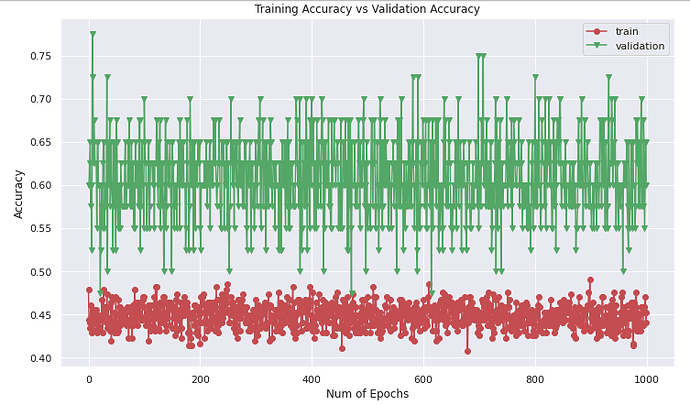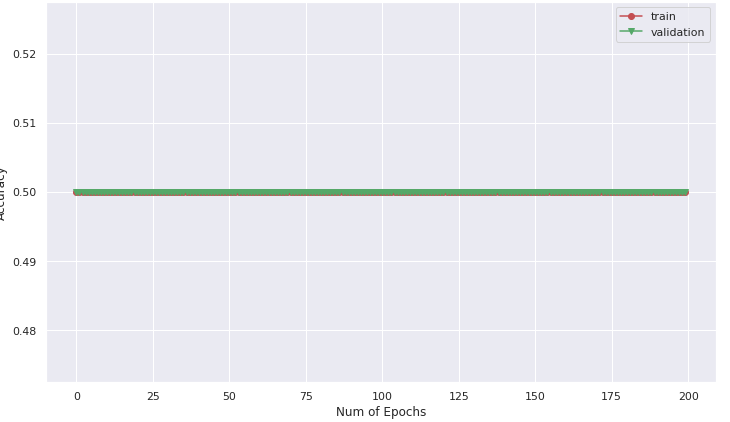I used Pytorch to create 3D CNN with 2 conv layer
I used 1000 epochs as shown in the curve but the accuracy and the loss values are almost stable.
can you explain the reason to me please ?
class CNNModel(nn.Module):
def __init__(self):
super(CNNModel, self).__init__() # héritage
self.conv_layer1 = self._conv_layer_set(3, 32)
self.conv_layer2 = self._conv_layer_set(32, 64)
self.fc1 = nn.Linear(64*28*28*28, 2)
self.fc2 = nn.Linear(1404928, num_classes)
self.relu = nn.LeakyReLU()
self.batch=nn.BatchNorm1d(2)
self.drop=nn.Dropout(p=0.15, inplace = True)
def _conv_layer_set(self, in_c, out_c):
conv_layer = nn.Sequential(
nn.Conv3d(in_c, out_c, kernel_size=(3, 3, 3), padding=0),
nn.LeakyReLU(),
nn.MaxPool3d((2, 2, 2)),
)
return conv_layer
def forward(self, x):
# Set 1
out = self.conv_layer1(x)
out = self.conv_layer2(out)
out = out.view(out.size(0), -1)
out = self.fc1(out)
out = self.relu(out)
out = self.batch(out)
out = self.drop(out)
out = F.softmax(out, dim=1)
return out
# Create CNN
model = CNNModel()
model.cuda() #pour utiliser GPU
print(model)
# Cross Entropy Loss
for param in model.parameters():
param.requires_grad = True
error = nn.CrossEntropyLoss()
# SGD Optimizer
learning_rate = 0.001
optimizer = torch.optim.SGD(model.parameters(), lr=learning_rate)
###################################################accuracy function ##################################
def accuracyCalc (predicted, targets):
correct = 0
p = predicted.tolist()
t = targets.flatten().tolist()
for i in range(len(p)):
if (p[i] == t[i]):
correct +=1
accuracy = 100 * correct / targets.shape[0]
return(accuracy)
#######################################################################################################
print(" build model --- %s seconds ---" % (time.time() - start_time))
#######################################################{{{{{{{training}}}}}}}##################################
print('data preparation ')
training_data = np.load("/content/drive/My Drive/brats6G/train/training_data.npy", allow_pickle=True)
training_data = training_data[:2]
targets = np.load("/content/drive/My Drive/brats6G/train/targets.npy", allow_pickle=True)
targets = targets[:2]
from sklearn.utils import shuffle
training_data, targets = shuffle(training_data, targets)
training_data = changechannel(training_data, 1, 5) #Channels ordering : first channel to ==> last channel'
training_data = resize3Dimages(training_data) #resize images
training_data = channel1to3(training_data,)#1 channel to 3 channel ===> RGB
training_data = changechannel(training_data, 4, 1)# last to first
#Definition of hyperparameters
num_epochs = 5
loss_list_train = []
accuracy_list_train = []
for epoch in range(num_epochs):
outputs = []
outputs= torch.tensor(outputs).cuda()
for fold in range(0, len(training_data), 4):
xtrain = training_data[fold : fold+4]
xtrain =torch.tensor(xtrain).float().cuda()
xtrain = xtrain.view(2, 3, 120, 120, 120)
# Clear gradients
optimizer.zero_grad()
# Forward propagation
v = model(xtrain)
outputs = torch.cat((outputs,v.detach()),dim=0)
targets = torch.Tensor(targets)
labels = targets.cuda()
outputs = torch.tensor(outputs, requires_grad=True)
_, predicted = torch.max(outputs, 1)
accuracy = accuracyCalc(predicted, targets)
labels = labels.long()
labels=labels.view(-1)
loss = nn.CrossEntropyLoss()
loss = loss(outputs, labels)
# Calculating gradients
loss.backward()
# Update parameters
optimizer.step()
loss_list_train.append(loss.data) #loss values loss
accuracy_list_train.append(accuracy/100)
np.save('/content/drive/My Drive/brats6G/accuracy_list_train.npy', np.array(accuracy_list_train))
np.save('/content/drive/My Drive/brats6G/loss_list_train.npy', np.array(loss_list_train))
print('Iteration: {}/{} Loss: {} Accuracy: {} %'.format(epoch+1, num_epochs, loss.data, accuracy))
print('Model training : Finished')

